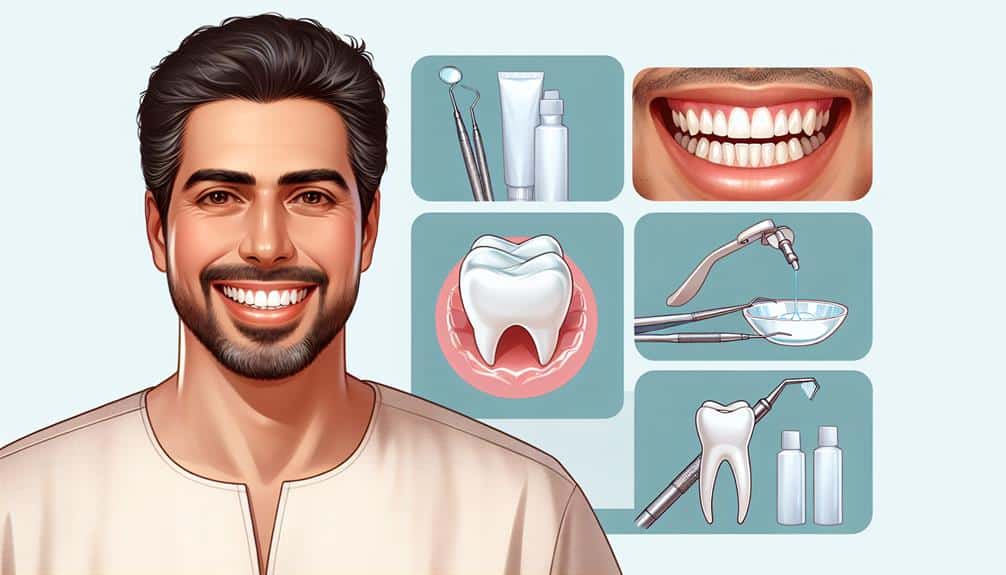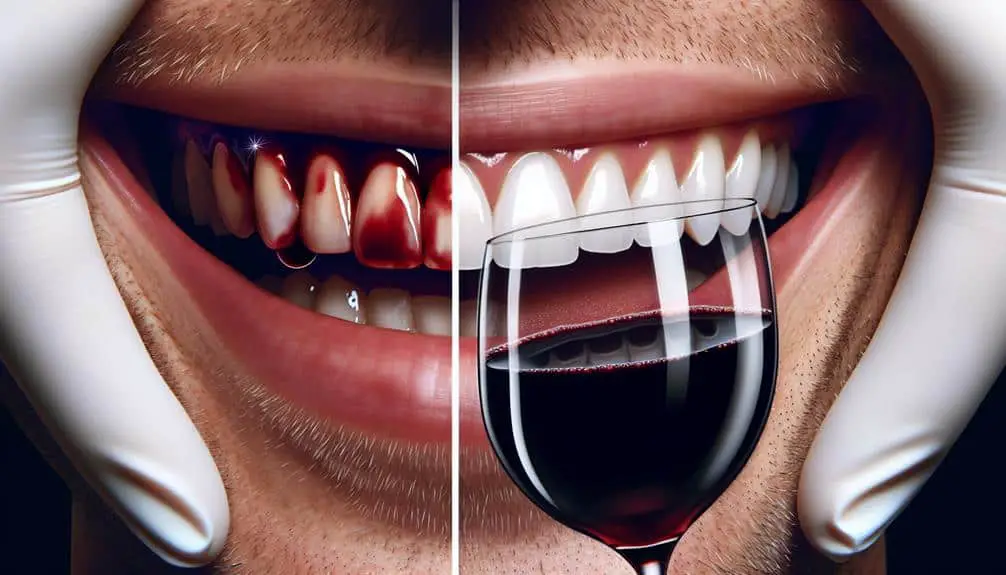Brighten your smile at home with oil pulling using coconut or olive oil for antimicrobial benefits. Try baking soda's gentle abrasiveness to remove stains and balance mouth pH. Use hydrogen peroxide effectively but be cautious of excess. Apple cider vinegar's acidity combats stains and bacteria. Activated charcoal absorbs impurities when used consistently. Opt for turmeric toothpaste or crunchy fruits to scrub teeth naturally. Strawberries contain malic acid for whitening, while lemon juice and baking soda paste can gently remove stains. Explore the natural whitening properties of orange peel. Transform your smile in simple ways from home.
Key Points
- Use coconut oil pulling to reduce stains and promote oral health naturally.
- Try baking soda for gentle abrasion and pH balance without enamel damage.
- Apply hydrogen peroxide effectively to break down stains for whiter teeth.
- Consider apple cider vinegar for its stain-removing and pH-balancing properties.
- Use activated charcoal regularly to absorb stains and maintain teeth whiteness.
Oil Pulling
To brighten teeth discoloration at home, consider incorporating oil pulling into your oral hygiene routine. Both coconut oil pulling and olive oil pulling are popular methods for DIY teeth whitening and natural tooth brightening.
Coconut oil pulling involves swishing a tablespoon of coconut oil in your mouth for about 15-20 minutes. The lauric acid present in coconut oil has antimicrobial properties, which may help reduce bacteria in the mouth that can contribute to plaque buildup and yellowing of teeth. Additionally, coconut oil is known for its potential to reduce inflammation and promote overall oral health.
On the other hand, olive oil pulling is another effective technique for natural tooth brightening. Olive oil contains compounds such as polyphenols and tocopherols, which have antioxidant properties that could potentially help in removing stains from the teeth and promoting gum health.
Incorporating either coconut oil pulling or olive oil pulling into your oral care routine could be a simple yet beneficial way to work towards a brighter, healthier smile.
Baking Soda
If you're thinking about using baking soda to brighten teeth discoloration at home, it's important to understand its benefits, method, and precautions.
Baking soda is recognized for its abrasive properties that can assist in removing surface stains on teeth. However, excessive use can erode enamel, so it's vital to use it sparingly and with caution.
Baking Soda Benefits
Baking soda, a versatile household ingredient, offers numerous benefits for brightening teeth discoloration at home. Its alkaline nature helps balance the pH level in your mouth, creating an environment less conducive to the growth of bacteria that cause discoloration.
Additionally, baking soda has gentle abrasiveness that can help remove surface stains from teeth without damaging the enamel. By using baking soda as a natural teeth whitener, you can benefit from its ability to protect your enamel while effectively removing stains.
Baking Soda Method
With its gentle abrasiveness and alkaline properties, baking soda offers a natural and effective method for brightening teeth discoloration at home.
Here are three ways you can incorporate baking soda into your DIY teeth whitening routine:
- Baking Soda Paste: Mix a small amount of baking soda with water to create a paste. Brush this paste onto your teeth gently for 1-2 minutes.
- Baking Soda and Lemon Juice: Combine baking soda with lemon juice to form a paste. Lemon juice's acidity enhances the whitening effect of baking soda.
- Baking Soda and Hydrogen Peroxide: Blend baking soda with hydrogen peroxide to create a paste. Hydrogen peroxide is a common ingredient in toothpaste alternatives for its whitening properties.
These methods can be effective, but it's crucial to use them sparingly to avoid damaging your enamel.
Baking Soda Precautions
When considering using baking soda for teeth discoloration, it's important to be mindful of potential precautions to protect your enamel and oral health.
While baking soda is commonly used for its teeth-whitening properties, it can be essential and may wear down tooth enamel if used excessively. To mitigate this risk, consider alternatives like hydrogen peroxide or activated charcoal, which are gentler on the enamel.
Additionally, it's essential to avoid brushing too vigorously or frequently with baking soda to prevent enamel erosion. If you choose to use baking soda, do so sparingly and in moderation to safeguard your tooth enamel.
Hydrogen Peroxide
To effectively address teeth discoloration at home, consider incorporating hydrogen peroxide into your oral care routine. Hydrogen peroxide is a common ingredient in many whitening products due to its ability to break down stains and lighten the color of your teeth. Here are three ways you can use hydrogen peroxide for teeth whitening at home:
- Hydrogen Peroxide Rinse: Mix equal parts of hydrogen peroxide and water to create a mouthwash. Swish this solution around in your mouth for 1 minute, then spit it out. Be careful not to swallow the mixture.
- Hydrogen Peroxide and Baking Soda Paste: Create a paste by mixing hydrogen peroxide with baking soda until it forms a thick consistency. Gently brush your teeth with this paste for 1-2 minutes, then rinse thoroughly.
- Hydrogen Peroxide Soak: Soak a clean cloth in hydrogen peroxide and gently rub it on the surface of your teeth for a few seconds. Rinse your mouth afterward.
Apple Cider Vinegar
Apple cider vinegar is known for its potential teeth-whitening benefits due to its acidic nature that may help remove stains.
To apply it, dilute the vinegar with water and swish it around in your mouth for a few minutes before brushing your teeth.
Remember to use it sparingly to avoid damaging your tooth enamel from excessive acidity.
Benefits of Vinegar
Enhance your teeth's brightness naturally with the benefits of vinegar, particularly Apple Cider Vinegar. Here are three reasons why vinegar can help whiten your teeth:
- Acetic Acid: Vinegar contains acetic acid, which has been shown to effectively remove stains on teeth caused by factors like coffee or smoking.
- Antibacterial Properties: The antibacterial properties of vinegar can help combat bacteria in the mouth that contribute to plaque buildup, which can cause teeth to appear yellow.
- pH Balance: Apple Cider Vinegar helps balance the pH levels in the mouth, creating an environment less conducive to the growth of bacteria that can lead to discoloration.
How to Apply
Brightening teeth discoloration at home can be effectively done by applying Apple Cider Vinegar using a simple and straightforward method. To start, mix one part Apple Cider Vinegar with two parts water.
Swish this solution around in your mouth for about 1-2 minutes. Be cautious not to leave it on for too long as it can erode tooth enamel. After rinsing your mouth thoroughly with water, brush your teeth with a fluoride toothpaste to remove any remaining vinegar residue.
Consistency in this practice is key to seeing results. Remember, while Apple Cider Vinegar is a cost-effective solution for teeth discoloration, consulting with your dentist for toothpaste recommendations and professional teeth whitening options for more severe cases is crucial.
Activated Charcoal
Using activated charcoal can help reduce teeth discoloration by effectively absorbing stains and impurities from the surface of your teeth. Here are three key points to keep in mind when using activated charcoal for teeth whitening:
- Application: Charcoal toothpaste typically contains activated charcoal and is designed for regular use. Gently brush your teeth with the charcoal toothpaste for about two minutes to allow the charcoal to absorb surface stains effectively.
- Frequency: When using activated charcoal for teeth whitening, it's crucial to maintain consistency. Incorporate charcoal teeth whitening into your oral care routine a few times a week to see best results over time.
- Rinsing: After brushing with activated charcoal, thoroughly rinse your mouth to remove any residue. It's important to rinse until no black residue remains in your mouth to prevent potential staining of clothes or towels.
Brushing With Turmeric
To further enhance teeth discoloration, consider exploring the benefits of brushing with turmeric, a natural remedy known for its potential whitening properties. Turmeric contains curcumin, a compound with antioxidant and anti-inflammatory effects that may help in reducing plaque and gingivitis, contributing to a healthier oral environment. Its antimicrobial properties can also assist in combating bacteria that cause bad breath.
Creating a DIY turmeric toothpaste is a simple and cost-effective way to incorporate this natural teeth whitening remedy into your oral care routine. Mix turmeric powder with coconut oil to form a paste, adding a dash of peppermint oil for freshness. Gently brush your teeth with this mixture for a couple of minutes, allowing the turmeric to work its magic. However, be cautious as turmeric can stain clothing and surfaces, so ensure thorough rinsing after use.
While turmeric may show promising results in brightening teeth, it's essential to consult with your dentist before starting any new oral care regimen to make sure it's suitable for your dental health needs.
Eating Crunchy Fruits and Vegetables
Incorporating crunchy fruits and vegetables into your diet can contribute to maintaining a healthy and bright smile. These foods can help improve oral hygiene and support your dietary habits. Here are three reasons why adding crunchy fruits and vegetables to your meals can benefit your teeth:
- Essential Scrubbing Action: Crunchy fruits and vegetables like apples, carrots, and celery require a lot of chewing, which can help mechanically clean your teeth. The fibrous texture of these foods acts as a natural toothbrush, assisting in removing plaque and food particles from your teeth's surfaces.
- Vital Saliva Production: Chewing crunchy fruits and vegetables stimulates saliva production. Saliva plays an important role in maintaining oral health by neutralizing acids, remineralizing enamel, and washing away food debris. This natural process helps in preventing tooth decay and keeping your teeth bright.
- Rich in Nutrients: Fruits and vegetables are packed with essential vitamins and minerals that support overall dental health. Incorporating a variety of these foods into your diet can contribute to stronger teeth and gums, promoting a brighter smile.
Using Strawberries
Strawberries offer a natural and effective method for brightening teeth discoloration at home. These DIY teeth whitening solutions are popular due to their fruit-based remedies that can help combat stains on your teeth.
Strawberries contain malic acid, a natural enzyme that works as an astringent to remove surface tooth discoloration. To create a simple at-home remedy, mash up one ripe strawberry and mix it with a pinch of baking soda to form a paste. Apply this mixture to your teeth using a soft-bristled toothbrush, gently scrubbing for a few minutes before rinsing thoroughly.
It's important to note that while strawberries can help brighten teeth, they aren't a substitute for professional teeth whitening treatments. Overuse of fruit acids like malic acid can potentially damage tooth enamel, so it's best to use this remedy sparingly. Remember to brush your teeth with regular toothpaste afterward to remove any remaining fruit residue and maintain good oral hygiene.
Incorporating strawberries into your oral care routine can be a natural and invigorating way to enhance your smile.
Lemon Juice and Baking Soda Paste
Brighten your teeth discoloration at home by creating a paste using lemon juice and baking soda. This DIY teeth whitening method combines the acidity of lemon juice with the abrasive properties of baking soda to help remove surface stains on your teeth.
Here are three key points to keep in mind when using this homemade whitening solution:
- Citrus Precautions: Lemon juice is highly acidic and may erode tooth enamel if used excessively. To prevent damage, limit the frequency of this treatment to once or twice a week.
- Proper Mixing: Combine a small amount of lemon juice with baking soda to form a paste with a consistency similar to toothpaste. This ensures the mixture isn't too abrasive on your teeth.
- Gentle Application: Apply the paste to your teeth using a soft toothbrush or your finger. Gently brush the paste onto your teeth for about a minute before rinsing thoroughly. Remember not to scrub too hard to avoid enamel damage.
Orange Peel Rub
Using orange peel to rub on your teeth can be a natural way to brighten tooth discoloration as it contains natural whitening properties.
This method is simple and effective, making it a convenient option for home teeth whitening.
Give it a try to see if this natural remedy can help improve the appearance of your teeth.
Natural Whitening Properties
To enhance the natural whitening properties of orange peel, consider incorporating this simple yet effective method into your dental care routine. Orange peels contain compounds that can help brighten teeth discoloration when used consistently.
Here are three steps to maximize the benefits of orange peel:
- Peel Preparation: Gently remove the outer orange peel and allow it to dry for a few days to enhance its whitening properties.
- Rubbing Technique: Rub the inside of the dried orange peel against your teeth for about two minutes, ensuring all surfaces are covered.
- Rinse and Repeat: Rinse your mouth thoroughly after rubbing and repeat this process daily to see gradual improvements in teeth brightness.
Incorporating this DIY technique can be an affordable and natural remedy for teeth discoloration.
Simple and Effective
Enhance your dental care routine with the simple yet effective method of rubbing dried orange peel against your teeth to maximize its natural whitening properties.
While professional treatments and DIY whitening kits can be expensive, orange peel offers a cost-effective alternative. The natural citric acid in orange peel helps to break down stains on the teeth, making it an excellent addition to your oral care regimen.
Simply rub the inside of the orange peel against your teeth for a few minutes, then rinse thoroughly. Regular use of this method can complement other teeth whitening strips or homemade remedies, providing a subtle but noticeable improvement in the brightness of your smile.
Give this natural remedy a try and see the results for yourself!
Frequently Asked Questions
Can Oil Pulling Help With Teeth Discoloration Caused by Smoking or Coffee?
Oil pulling, a traditional practice, may help remove teeth discoloration from smoking or coffee. Benefits include natural cleansing and potential whitening effects. Drawbacks may include time commitment and lack of scientific evidence for its effectiveness.
Is It Safe to Use Baking Soda as a Teeth Whitening Remedy Every Day?
Using baking soda as a daily teeth whitening remedy may seem effective, but it can be abrasive on enamel. Consider alternatives like activated charcoal or hydrogen peroxide. Prioritize daily tooth care with gentle methods to prevent damage.
How Often Should Hydrogen Peroxide Be Used to Whiten Teeth Effectively?
To whiten teeth effectively with hydrogen peroxide, use it no more than once a week. Incorporate proper brushing techniques and avoid staining foods like coffee and wine. Consistency is key for achieving and maintaining a brighter smile.
Can Apple Cider Vinegar Cause Damage to Tooth Enamel When Used for Whitening?
Can apple cider vinegar harm your enamel due to its acidity? Vinegar's high acidity can lead to enamel erosion, causing damage over time. It is crucial to be cautious when using it for whitening and consider potential risks.
Are There Any Potential Risks or Side Effects of Using Activated Charcoal for Teeth Whitening at Home?
When using activated charcoal for teeth whitening at home, potential risks and side effects may include enamel abrasion, tooth sensitivity, and gum irritation. Always consult with a dentist before trying charcoal whitening or any home remedies.



